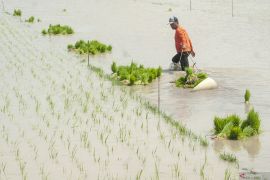Jakarta (ANTARA) - The food estate program is currently running well and has had a positive impact on farmers and regions, the Ministry of Agriculture has said. "The effect is not instant. We need to process and prepare land for the food barn. We also listen to inputs from the public and try to update the food estate's progress," head of the ministry's public relations and information bureau, Kuntoro Boga Andri, said in a statement released on Wednesday.
He then outlined some efforts that have been made simultaneously to expand food barns through extensification and crop intensification programs in Pulang Pisau, Kapuas, Humbang Hasundutan, Central Sumba, Temanggung, and Wonosobo.
Andri said that even though it takes time to improve the quality of soil and planting at food estate locations, his party has experience in preparing and cultivating marginal land in Banyuasin, South Sumatra. "We cannot only strengthen land productivity in Java. It cannot keep up with population growth. Thus, we need to increase our food production for the long term," he added.
For preparing new and potential agricultural land, the use of technology is necessary, especially for land management and water management, Andri said. "We also need to prepare superior seeds. We have prepared it at the food estate location. The positive impact is also starting to be seen," he informed.
An example of successful intensification efforts in Central Kalimantan has been Pulang Pisau area, which has seen increased productivity from year to year. From producing 2.5 tons per hectare of dry harvested grain on average, the region has managed to increase production to 3.5 tons per hectare, and even 5.5 tons per hectare, Andri disclosed.
Baca juga: President University mendapat izin mendirikan fakultas kedokteran
Baca juga: Governor invites public to emulate president's tree-planting spirit
In Central Sumba, the local government has managed to reduce the poverty rate in the food estate area and its surroundings, he added. "Wonosobo farmers also gain the benefits with tangible indicators from increased crop productivity, guaranteed commodity marketing, and increased farmer income in the food estate area," he noted.










